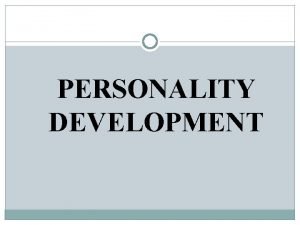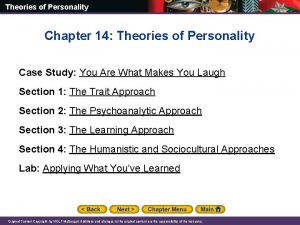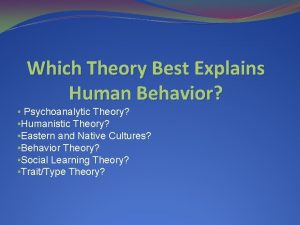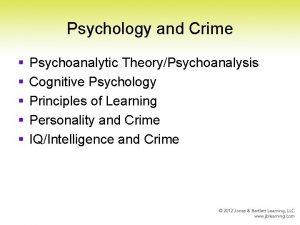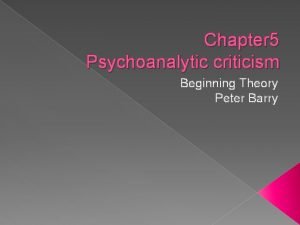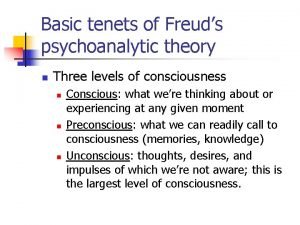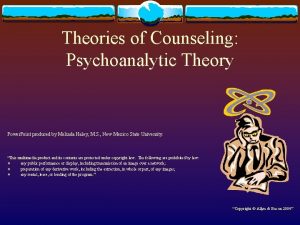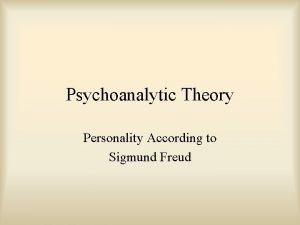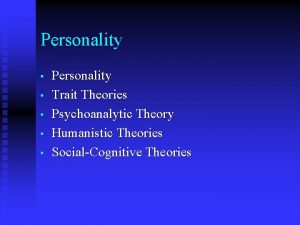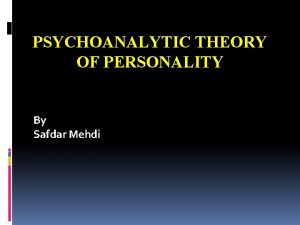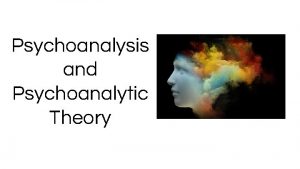Psychoanalytic Theory of Personality Introduction Psychoanalytic theory is











- Slides: 11

Psychoanalytic Theory of Personality

Introduction • Psychoanalytic theory is theory of personality organization and the dynamics of personality development that guides psychoanalysis, a clinical method for treating psychopathology. First laid out by Sigmund Freud in the late 19 th century, psychoanalytic theory has undergone many refinements since his work.

Personality structure • Sigmund Freud determined that the personality consists of three different elements, the id, the ego and the superego.

Id • The id acts in accordance with the pleasure principle, in that it avoids pain and seeks pleasure. Due to the instinctual quality of the id, it is impulsive and often unaware of implications of actions.

Ego • The ego is driven by reality principle. The ego works to balance both the id and superego. To balance these, it works to achieve the id's drive in the most realistic ways. It seeks to rationalize the id's instinct and please the drives that benefit the individual in the long term. It helps separate what is real, and realistic of our drives as well as being realistic about the standards that the superego sets for the individual.

Super ego • The superego is driven by morality principle. It acts in connection with the morality of higher thought and action. Instead of instinctively acting like the id, the superego works to act in socially acceptable ways. It employs morality, judging our sense of wrong and right and using guilt to encourage socially acceptable behavior.

Topographical and Dynamic Aspects

The unconscious • The unconscious is the portion of the mind of which a person is not aware. Freud said that it is the unconscious that exposes the true feelings, emotions, and thoughts of the individual. There are variety of psychoanalytic techniques used to access and understand the unconscious, ranging from methods like hypnosis, free association, and dream analysis. Dreams allow us to explore the unconscious; according to Freud, they are "the 'royal road' to the unconscious.

• Dreams are composed of latent and manifest content. Whereas latent content is the underlying meaning of a dream that may not be remembered when a person wakes up, manifest content is the content from the dream that a person remembers upon waking and can be analyzed by a psychoanalytic psychologist. Exploring and understanding the manifest content of dreams can inform the individual of complexes or disorders that may be under the surface of their personality. Dreams can provide access to the unconscious that is not easily accessible.

• Freudian slips (also known as parapraxes) occur when the ego and superego do not work properly, exposing the id and internal drives or wants. They are considered mistakes revealing the unconscious. Examples range from calling someone by the wrong name, misinterpreting a spoken or written word, or simply saying the wrong thing.

Thank You
 Oral stage of development
Oral stage of development What does the psychoanalytic approach to personality teach?
What does the psychoanalytic approach to personality teach? Oral fixation personality
Oral fixation personality What does the psychoanalytic approach to personality teach?
What does the psychoanalytic approach to personality teach? Carl rogers theory
Carl rogers theory Sigmund freud psychoanalytic theory
Sigmund freud psychoanalytic theory Psychoanalytic theory criminology
Psychoanalytic theory criminology Freud's theory
Freud's theory Definition of psychoanalytic criticism
Definition of psychoanalytic criticism Psychoanalytic theory defense mechanisms
Psychoanalytic theory defense mechanisms Main tenets of freud psychoanalytic theory
Main tenets of freud psychoanalytic theory Psychoanalysis
Psychoanalysis
